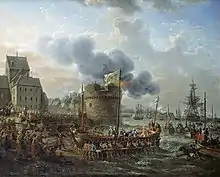Escadre d'évolution
An Escadre d'évolution (French, literally "Evolution squadron") is a squadron of warships of the French Navy cruising in peacetime for the purpose of training their crew and student officers.[1][2]
History
The French Navy started organising Escadre d'évolution early in its existence. During the 17th century, Tourville conducted such exercises. [2]
The practice fell in disuse due to an era of wars and lack of credits. During the reign of Louis XVI, the Navy restored the practice under Duchaffault and Orvilliers.[2] In 1772, Orvilliers was cruising off the shores of France for several weeks, with his flag on the 64-gun Alexandre.[3][4] Duchaffault captained the 50-gun Fier,[5] and the frigate Aurore was also part of the squadron.[6] Minister Sartine then instituted such cruises as yearly events.[4]
In 1775, Guichen was conducting his own exercises from Brest[7][8] with a 12-ship division comprising four frigates, five corvettes, a lugger and two cutters, and 1885 men, with his flag on the 36-gun frigate Terpsichore.[4] On 8 September 1775, Guichen's training squadron appeared on the horizon and was in port a mere two hours later; the event shook Sartine, who remarked that the defences of Brest could never be manned in such a short time, and thus had to be reinforced and maintained at a constant state of readiness, even in peacetime.[9]
In 1776, Sartine increased the strength of the Escadre d'évolution to 17 ships, including three ships of the line, seven frigates, five corvettes and two cutters.[10] It was organising in three divisions, each under a Chef d'Escadre with his flag on a ship of the line: Du Chaffault, holding exercises from Brest[11] with his flag on the 74-gun Zodiaque; Abon, on the 64-gun Provence; and Chartres, on the 64-gun Solitaire. From 10 May, the squadron conducted a four-month cruise between Ushant and Cape Finisterre, and with 3,705 men — fewer than in wartime, but noticeably more than the normal peacetime complement.[12] The frigate Diligente, under Lieutenant Amblimont, took part in the exercises.[13]
Training at sea resumed after the War of American Independence and the related Anglo-French War that ended in 1783. Notably, when Louis XVI visited Cherbourg naval base in April 1786 to mark the completion of a sea wall, the Escadre d'évolution held a naval review and naumachia under Chef d'Escadre Albert de Rions, with his flag on the 74-gun Patriote.[14]
 Louis XVI visiting Cherbourg in 1786, by Louis-Philippe Crépin
Louis XVI visiting Cherbourg in 1786, by Louis-Philippe Crépin
The French Revolutionary Wars and Napoleonic Wars removed the opportunity to conduct training cruises for a whole era again. In the 1840s, the practice was reintroduced under the impulsion of such officers as Lalande.[15]
See also
- The United States Navy had a Squadron of Evolution in the late 19th century.[16]
- The Brazilian Navy also had an Evolution Squadron in the late 19th century.
Citations
- "s.v. Escadre". Vocabolario di marina in tre lingue. Vol. 2. Milan: Imprimerie Royale. Dalla Stamperia Reale. 1813. p. 91. Retrieved 1 May 2010.
Escadre d'évolutions... A squadron fitted out for the purposes of exercising
- Vergé-Franceschi (2002), p. 557.
- Archives nationales (2011), p. 189.
- Lacour-Gayet (1905), p. 72.
- Taillemite (2002), p. 149.
- Roche (2005), p. 58.
- Archives nationales (2011), p. 198.
- Archives nationales (2011), p. 200.
- Lacour-Gayet (1905), p. 25.
- Lacour-Gayet (1905), p. 79.
- Archives nationales (2011), p. 202.
- Lacour-Gayet (1905), p. 80-81.
- Roche (2005), p. 152.
- Lacour-Gayet (1905), p. 589.
- Taillemite (2002), p. 294—295.
- Rentfrow (2014), p. 2014.
References
- Lacour-Gayet, Georges (1905). La marine militaire de la France sous le règne de Louis XVI. Paris: Honoré Champion. OCLC 763372623.
- Rentfrow, James C. (2014). Home Squadron: The U.S. Navy on the North Atlantic Station. Annapolis, Maryland: Naval Institute Press. ISBN 1-61251-447-2. OCLC 865711810.
- Roche, Jean-Michel (2005). Dictionnaire des bâtiments de la flotte de guerre française de Colbert à nos jours 1 1671 - 1870. ISBN 978-2-9525917-0-6. OCLC 165892922.
- Taillemite, Étienne (2002). Dictionnaire des Marins français. Tallandier. ISBN 2-84734-008-4. OCLC 606770323.
- Troude, Onésime-Joachim (1867). Batailles navales de la France (in French). Vol. 2. Challamel ainé. OCLC 836362484.
- Vergé-Franceschi, Michel (2002). Dictionnaire d'Histoire maritime. Paris: Robert Laffont. ISBN 2-221-08751-8.
External links
- Archives nationales (2011). "Fonds Marine, sous-série B/4: Campagnes, 1571-1785" (PDF). Retrieved 29 April 2020.